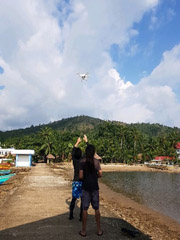Filipino, Japanese scientists use drones to assess impact of river discharges to underwater vegetation
2021.03.18

Survey in Palawan using UAV, photo courtesy of Tamondong
Filipino and Japanese scientists, under a development cooperation project between Japan International Cooperation Agency (JICA) and the Philippines, are exploring the power of unmanned aerial vehicles (UAV), more popularly known as drones, to assess the impacts of river discharges on coastal ecosystems.
"Submerged aquatic vegetation (SAV) like seagrass plays an important role in the coastal ecosystem. Marine animals find shelter and food in this SAV. Unfortunately, seagrass beds are one of the most neglected ecosystems," said Ayin Tamondong, a member of the research team of the ongoing project The Comprehensive Assessment and Conservation of Blue Carbon Ecosystems and their Services in the Coral Triangle or BlueCARES.
In addition to serving as a habitat for marine animals, seagrass and other SAV capture carbon dioxide, a major contributor to climate change. The carbon stored by coastal ecosystems is called blue carbon.
Under the BlueCARES project, Filipino and Japanese scientists from the University of the Philippines Diliman (UPD), Tokyo Institute of Technology (TIT), and Ministry of Marine Affairs and Fisheries in Indonesia are working together to come up with a Blue Carbon Strategy to guide policy makers in finding science-based solutions to coastal management issues.
Tamondong's study on SAV was highlighted in a paper "Investigating the Effects of River Discharges on Submerged Aquatic Vegetation Using UAV Images and GIS Techniques," one of several scientific papers that form part of BlueCARES. The paper showed that SAVs decline is largely undocumented, emphasizing the need for a cost-effective method to monitor them. Further, SAVs are less protected under Philippine environmental laws compared to other coastal ecosystems such as mangroves and coral reefs.
BlueCARES scientists said that using remote sensing technology such as drones will enable the Philippines to monitor properly these SAVs that had been largely affected by river discharges caused by human activities, unsustainable tourism, and unsustainable aquaculture practices. In one of the project's pilot sites in Busuanga in Palawan, mangroves, seagrasses, and coral reefs are abundant and relatively undisturbed. This condition provides scientists the opportunity to measure water quality in its full range of conditions and study their impacts at different levels of marine biodiversity and state of conservation of the Blue Carbon ecosystems.
UPD and TIT researchers classified the marine biodiversity in Busuanga using sensors and assessed the water turbidity of the site. It was found that water is highly turbid near the river mouth and where there is less cover of seagrass and seaweed. "We discovered that for us to properly manage our natural resources, there has to be recognition of the relationship between different marine resources and the environment," the paper explained.
In due course, the said study aims to contribute to a local Blue Carbon strategy through a Blue Carbon Network (BCnet) adopting Citizen Science in which government organizations, local government units, academe, and private sector work with scientists and researchers to promote coastal conservation, specifically the blue carbon ecosystems.
The BlueCARES Project is supported by the Science and Technology Research Partnership for Sustainable Development (SATREPS) initiative of JICA and Japan Science and Technology Agency (JST).
scroll